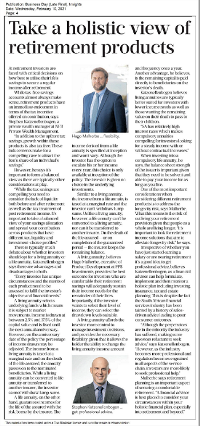Taking a balanced view of retirement products
At retirement investors are faced with critical decisions on how best to utilise their life’s savings to secure a regular income after retirement.

While tax free savings accounts almost always make sense, retirement products have an immediate enticement in terms of the tax incentive offered on contribution, says Stephen Katzenellenbogen, a private wealth manager at NFB Private Wealth Management. “In addition to the upfront tax savings, growth within these products is also tax free. These inducements make for a compelling case to attract the lion’s share of an individual’s savings.”
However, he says it’s important to form a balanced view as there are typically other considerations at play. “While the tax savings are compelling you need to consider the lack of liquidity both before and after retirement as well as the tax treatment of post retirement income. It’s important to take a balanced view of your savings allocation and spread your contribution across products that have different tax, liquidity and investment-choice profiles.”
There is typically much debate about whether investors should a living annuity or a life annuity. Katzenellenbogen says there are advantages and disadvantages to both. “Every investor has unique circumstances and the merits of each product need to be assessed in order to fulfil the investor’s objective and financial needs.”
A living annuity selects underlying funds which means it is subject to market movements. Income is drawn at between 2.5% and 17.5% of the capital value and is fixed until the next annual anniversary. However, on the anniversary date of the policy the percentage of income drawn may be adjusted. The income from a living annuity is taxed at a marginal rate and on the death of the life assured, the annuity passes on to the nominated beneficiaries. While a living annuity can be converted to life annuity or transferred to another insurer, the investor cannot withdraw lump sums.
A life annuity, on the other hand, guarantees incomes for the life of the assured with the risk borne by the insurer. The income derived from a life annuity is specified at inception and won’t vary. Although the investor has the option to escalate his or her income every year, this choice is only available at inception of the policy. The investor is given no choice in the underlying investments. Similar to a living annuity, the income from a life annuity is taxed at a marginal rate and the investor can’t withdraw lump sums. Unlike a living annuity, however, a life annuity can’t be converted to a living annuity, nor can it be transferred to another insurer. On the death of the life assured – or on completion of the guaranteed period - the insurer keeps the remaining balance.
A living annuity, believes Hugo Malherbe, executive of Product Development at PPS Investments, provides the best outcome for investors given that it affords the investor more control to manage investment decisions, and provides the necessary flexibility given that it allows the holder the ability to change the living annuity income amount and frequency once a year. Another advantage, he believes, is that the remaining capital is paid directly to beneficiaries on the investor’s death.
Katzenellenbogen believes living annuities are typically better suited for investors with lower income needs as well as those wanting the remaining value on their death to pass to their children. “SA has relatively high interest rates which makes compulsory annuities very compelling for investors looking for a steady income with or without contractual increases.”
When investing into a compulsory life annuity, he says, the balance sheet strength of the issuer is important given that they need to be solvent and able to pay your income for as long as you live.
One of the most important considerations to bear in mind when considering different retirement products is to address the longevity risk, points out Malherbe. Essentially what this means is the risk of outliving your retirement provision given that people as a whole are living longer. “It’s important to look for retirement income solutions that aim to alleviate longevity risk,” he says.
Irrespective of whether you have just started earning a salary or are nearing retirement it’s a good idea to get professional advice, believes Katzenellenbogen, given that a financial advisor can help formulate, implement and then monitor a holistic plan including investing, insurance, tax and estate planning.
This is despite the fact that the South African financial services industry has been tainted by a history of sales driven advice leading to poor consumer outcomes. “Although the perpetrators are in the minority, the industry has suffered as a result making some investors reluctant to seek advice,” says Katzenellenbogen. “However, as the industry becomes more professional and regulation becomes engrained in all aspects of the service chain, investors are more likely to seek professional help.”
Malherbe agrees, adding that retirement planning is an important aspect of securing a comfortable retirement. “A financial advisor is best placed to consider your unique circumstances within your holistic financial plan, especially into retirement and beyond.”
 This article was originally published by Business Day on Wednesday, February 10. You can access the original print of this publication here.
This article was originally published by Business Day on Wednesday, February 10. You can access the original print of this publication here. Retirement provision is one of the most critical aspects of every individual's investment portfolio. With less than 6% of South Africans able to retire in comfort, planning for retirement is the most important thing you can do for your future today. Partner with one of our Private Wealth Managers to help you retire successfully.






.jpg?sfvrsn=3ccd9277_0&size=350)

.png?sfvrsn=38ac0893_0&size=350)

































